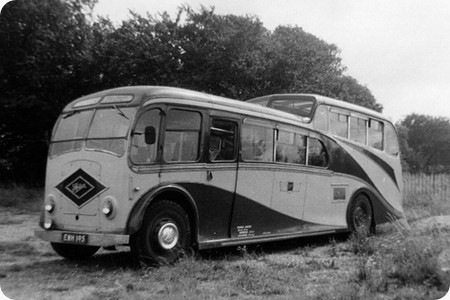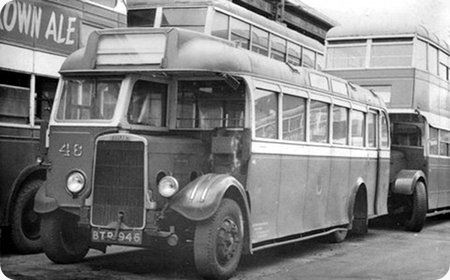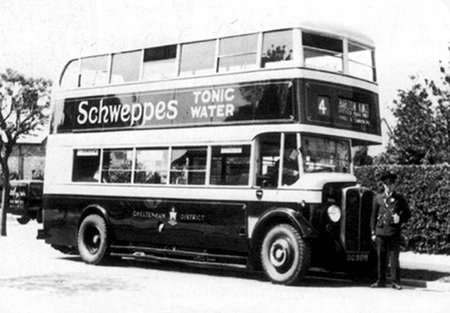
Copyright Ian Wild
Hargreaves of Bolton
Foden PVSC6
19??
Whitson RC35C
This great shot was taken at the Botanical Gardens Rhyl in August 1963 and at the time the above vehicle was owned by the Foden Sports and Social Club but it was delivered new to Hargreaves of Bolton. Bodywise is it called an Observation Coach or an Half-deck Coach? I can understand why it ended up with a sports a social club I should imagine that the large luggage locker came in handy for carrying all that equipment. Another question regarding this type of body I have is, were they limited to double decker regulations of length and weight for example or were the single decker lengths and weights allowed?
The PVSC6 had the Gardner 6LW 8·4 litre six cylinder diesel engine there was the option of the Gardner 5LW 7·0 litre five cylinder diesel engine in which case it was designated the PVSC5. In 1949 the Foden FE6 4·0 litre two stroke diesel engine was available which was designated the PVFE6 but only 52 PVFE6s were built as the series was superseded by the rear engined PVR in 1950.
Photograph contributed by Ian Wild
I can’t answer any of the technical questions about this coach, but I always remember these because Dinky Toys made one in the late 1950s and I had one; but to this day I’ve never seen an example of the real thing. There’s an example of the Dinky version here.
KC
Yes, KC – I’d forgotten about these. I used to have one. Weren’t they Maudsleys? It would be interesting to know why Dinky should choose such an unusual design of body and comparatively rare chassis for their model, especially when they were soon to become obsolete in style.
Paul Haywood
Didn’t Dinky do one in BOAC livery? I seem to remember the full-sized versions plying between Heathrow and the BOAC city terminal somewhere near Gloucester Road station – in the days before Heathrow Express, or even the extension of the Piccadilly Line beyond Hounslow West.
Stephen Ford
A couple of model makers made versions of airline-related coaches.
Dinky did this.
Matchbox did this.
KC
Its an observation coach, and Whitson built them on Maudslay, Leyland, AEC, and Foden chassis between 1949 and 1952. A half-deck coach is a different beast altogether using the patented "Crellin-Duplex" design where upper and lower deck seating was arranged to cram as many people in as possible using interlocking "railway compartment" style seating. The end result looked more like a two-level horsebox than a PSV! In prewar years Duple built a few observation coaches (I seem to remember one for an operator in South Wales) but in the post-war period Whitson had a virtual monopoly. The only other post-war example which springs to mind is the Mulliner bodied Morris-Commercial built for the Morris Works Band. This is preserved at the Oxford Bus Museum, but sadly none of the magnificent Whitson vehicles has survived.
The most famous Whitson observation coaches were the Fodens used by Salopia, but Dinky Toys chose to use a Maudslay supplied (in real life) to Embankment of Plymouth as the prototype for their scale model.
The airport coaches you mention were (in a sense) observation coaches, and share the same PSV Circle body prefix (RC) but all of those used by BEA in London (bodywork by Park Royal) and by MCTD in Manchester (bodied by Burlingham and Bond) had a continuous roofline rather than the "stepped" arrangement of a true observation coach, Liverpool Corporation converted a few (previously conventional) single-deckers to this "stepped roof" format in the late 1950s for their own airport service. The vehicles which resulted were not an aesthetic triumph!
Neville Mercer
07/02/11 – 06:04
As has already been pointed out, there was a world of difference between the Observation Coach style and that of the Half-Decker. Both were built to the (then) size limits for single deckers, rather than being restricted to the double decker dimensions. This applied regardless of whether they were mounted on front-engined chassis or rear-engined/underfloor-engined chassis. EWH 195 was one of a pair supplied to Hargreaves of Bolton, the other one being EBN 898. Both were supplied as PVSC6 chassis (Gardner 6LW), but after Fodens acquired EWH 195 they fitted a Foden two-stroke engine, effectively converting it to PVFE6 specification. Incidentally, you can tell the difference between front engined Gardner powered and Foden powered PSVs by the position of the starting handle hole. In the case of the Gardner engine the hole is dead centre, whereas it is slightly offset to the offside when a Foden engine was fitted.
Peter Tulloch
14/04/11 – 05:00
I should imagine this was carrying the Foden band who performed all over the country, they had several Fodens over the years, some had a bandmaster mascot on the rad cap, a uniformed conductor (the musical type) waving a baton.
Bryan Yates
05/10/11 – 17:28
I too had the Dinky model but I also remember the actual bus around North Wales when I was a small boy in the late 1950’s-early 1960’s. I lived in Broughton and we always holidayed further up the coast so saw this bus quite regularly. I also liked the cream-liveried Crosville buses which seemed more exotic than the all green or green and cream Chester buses.
Happy days!
Paul Eaton-Jones
25/10/11 – 07:19
I agree with Bryan Yates’ assumption that this coach was carrying the Fodens Brass Band. My father was a Machine Shop Foreman until his death in 1964, and I can remember seeing the bus now and then around the Elworth works – if memory serves me well it was grey and blue, and sounded as though it had the 2-stroke engine. No doubt the extra storage was useful for the band instruments. On another note, I saw a red half-cab Foden coach at Astle Park steam rally in August – still in the Coppenhalls (Sandbach) coach firm’s livery. Lovely memories!
Malcolm Riley
27/07/12 – 14:50
Reference to Malcolm’s comments about the blue and grey coach for the Foden Works Band….
I was sent a photo a couple of days ago from a friend in the UK who saw what is probably this gorgeous looking old lady just last week at a rally in Newbury….If I knew how to load photos on to this site I’d do it, but maybe a quick Google would stir the memory cells into action, and might also provide more information about its current owners’ show schedule and dates….
Stuart C
27/07/12 – 15:51
Ah….An hour later and I would be kicking myself unmercifully if the old limbs could bend that far….
The old lady I was going on about is not only already well known on here…. www.old-bus-photos.co.uk/
But ever a star, she even has her own page on Wikipedia…. //de.wikipedia.org/
I’m sure that it’s just an age thing on my part, but what an absolutely wonderful example of what a British coach was meant to look like….
Stuart C
28/07/12 – 08:40
She’s a very attractive vehicle and the colour scheme certainly enhances her looks, too, Stuart.
Chris Hebbron
14/09/12 – 06:57
Beautiful Vehicle, Astons Coaches Marton operated HUJ 997 Foden PVFR Observation Coach Whitson. They also operated a Foden Crellin Duplex mentioned above KWT 976 with a Lincs Trailer Body as well as two other Crellin Duplex with Mann Egerton. Various other Fodens were operated including well known NBH 950 and JWY 999
David Aston
13/05/13 – 15:25
How many Whitson Observation Coaches were made.
David Aston
02/02/15 – 07:14
I’ve just been doing some research on Whitson’s observation coaches and the answer to "how many were built" seems to be 32 or 33. The biggest customer was the US Air Force which took either nine or ten (depending on which source you believe!) on 30 ft long Crossley SD42/9 chassis. These received the USAF serial numbers N967-976 (or N969-977 in one version, hence the discrepancy in total build numbers). They carried pseudo-Foden radiator grilles at the request of the customer and were delivered in 1951 for use on personnel transfers and by assorted USAF military bands. They appear to have been withdrawn in 1959 and at least one of them (N975) was subsequently sold to a civil operator (Peters of Llanarmon) as TCA 309. It was scrapped in 1962. Next came Salopia Saloon Coaches of Whitchurch and Embankment of Plymouth with five each. Salopia’s were all on Foden chassis, one of the shorter version on PVSC6 chassis (GAW 86), a 30ft long PVFE6 (GUJ 243) and three of the 30 ft version on rear-engined PVRF6s (HUJ 996/7 and JAW 334). Embankment took two on Maudslay Marathon IIIs (EJY 123/4), two on AEC Regal IIIs (FDR 52/3) and one on a Foden PVSC6 (GCO 946).
Four operators had two each. Hargreaves of Bolton took EBN 898 and EWH 195 on Foden PVSC6 chassis, HS Knight of Northampton received BNH 301 (Maudslay Marathon III) and BNH 302 (AEC Regal III), AE Marsh T/A Black and White of Harvington (Worcs) had Marathon IIIs HNP 875 and HUY 204), and ET Straw of Leicester bought Regal III GBC 893 and Regal IV HBC 603.
WEMS of Weston-super-Mare received Marathon III DFR 395. This vehicle was apparently the prototype – it had a slightly higher roof-line on the raised section – and had been an exhibit at the Earls Court Show in Batty Holt livery which might account for its Blackpool registration as they had a subsidiary there. However, it never entered service with the Lancashire firm and stayed with WEMS until 1960.
Other one-off customers were Cowell Bros of Sunderland (Regal III AGR 975), Doug Jones Coaches of Newchurch (Hants) who took Royal Tiger JOT 616 – the only Leyland example, Netherfield of Nottingham (Regal IV NAL 393), and Stanton Bros of Horseley Heath (Staffs) with Marathon III RRF 328.
Second-hand operators of observation coaches (apart from the previously mentioned Peters of Llanarmon) included Cooper of Gilesgate (Durham) who took two former Salopia PVRF6s, Elms Coaches of Kenton (London) who bought Embankment’s Foden GCO 946, and Ubique (also in the London area) who bought RRF 328.
Can anyone tell me of any I’ve missed? Past experience would suggest that there might be others lurking where I’ve failed to notice them!
The body came in two basic versions. The shorter variety can be recognised by having two full window bays on the sides of the raised section, while the 30 ft version has three. Both types could be adapted to suit any engine position (front/underfloor/rear).
In closing, can anybody tell me the liveries used by HS Knight of Northampton (taken over by York’s in 1960) or Stanton of Horseley Heath (who disappeared in 1956)? I have black and white shots of these operators’ vehicles and would like to get an idea of what they looked like in technicolour!
Neville Mercer
03/05/16 – 07:03
Whitson Observation Coaches
Having more or less concluded the History of Astons Coaches now delving deeply into the history of some of the vehicles they ran Have started on
Leyland Panda
Rutland Clipper
Crellin Duplex
Today I start on Whitson Observation Coaches so any points of reference or articles on these much appreciated Astons had HUJ 997 Foden
David Aston
04/05/16 – 14:56
GAW 86 One of the Salopia Fodens was converted to a Lorry are there any photos around?
HUY 204 It is well documented that the Foden won Concourse prizes, but why did HUY 204 Maudslay Marathon have a similar Concourse Badge on it this is at the Wythan Bus Museum
David Aston
19/05/16 – 06:15
I understand that there was possibly another one but records are unclear OFR 922 any one know anything about this one.
USAF Crossley I am led to believe N974 was registered as 8065 KD went to a Liverpool School. N976 was registered as 464 GBM went to Creed,Sandy
David Aston
 Vehicle reminder shot for this posting
Vehicle reminder shot for this posting
14/05/20 – 06:48
Black and White of Tipton (Stanton Bros?) also had at lest one.
Bill Parker
19/05/20 – 06:20
BLOTW reveals that Stanton had in fact two. RRF 328, a Maudslay Marathon III, has already been mentioned by Neville Mercer above, but there was also ORF 922, a Tilling Stevens K6LA7, no less. This is probably the ‘OFR 922’ that David Aston was enquiring about.
And I think Bill’s question probably answers Neville’s earlier question about Stantons’ livery!
Peter Williamson
20/05/20 – 07:16
Although it is correct that BLOTW lists ORF 922 as having an observation body, photographic evidence puts this in doubt. This photograph includes what is suggested as being that Tilling Stevens, which has a standard half cab body. Either the coach in the photograph is not ORF 922, or it was subsequently rebodied, which seems unlikely – https://flic.kr/p/or9CVv
David Williamson





